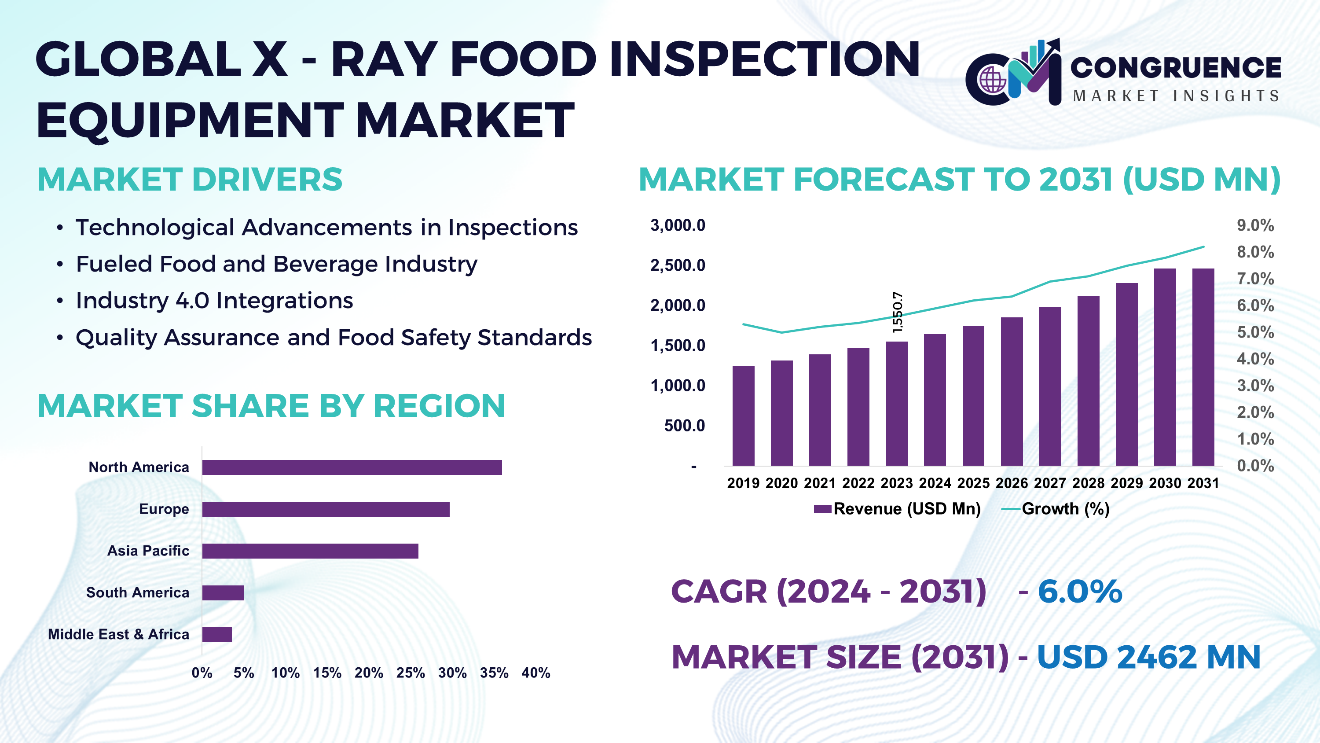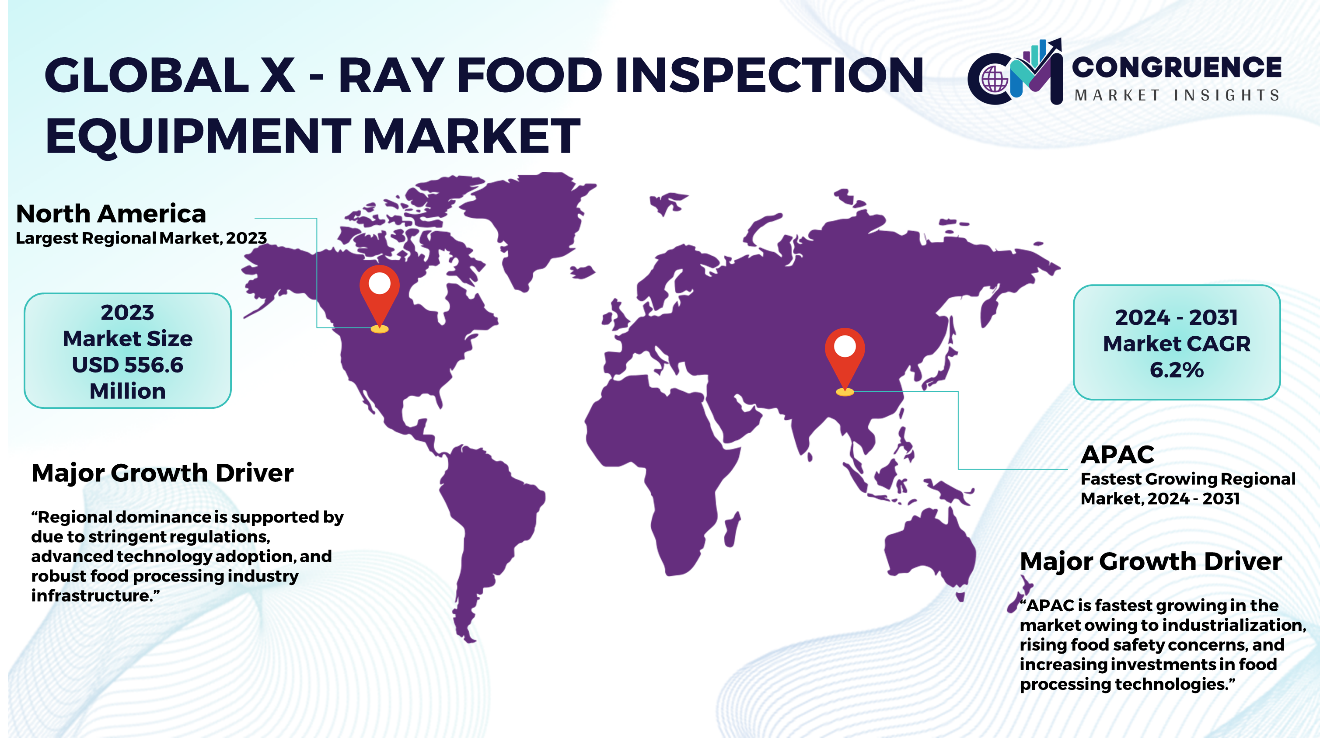Reports
The Global X-ray Food Inspection Equipment Market was valued at USD 1,550.7 Million in 2023 and is anticipated to reach a value of USD 2,462.0 Million by 2031 expanding at a CAGR of 6.0% between 2024 and 2031.
X-ray Food Inspection Equipment plays a pivotal role in ensuring food safety and quality within the global supply chain. The technological components, recent advancements, and the impact of artificial intelligence on food inspection process using X-ray technology. X-ray food inspection equipment comprises essential components, including an X-ray generator, detector system, and computer processing unit. The X-ray generator emits high-energy rays that penetrate food items, while the detector systems capture transmitted rays to generate detailed images. Within the computer unit analyze these images to identify contaminants, foreign objects, or defects in the food. Significant advancements in X-ray food inspection equipment include improved imaging resolution, faster processing speeds, and enhanced sensitivity to detect smaller contaminants. These innovations have greatly improved the accuracy and efficiency of food safety inspections, leading to higher-quality products in the market. The integration of AI has revolutionized food inspection by enabling automated analysis of X-ray images. AI algorithm can quickly identify potential issues based on extensive datasets, enhancing the precision and speed of quality control processes. X-Ray Food Inspection Equipment functions by conveying food items through a system where they are expose to X-ray radiation. As products move through the system, real-time images are captured and analyzed, allowing for rapid assessments of food safety without compromising product integrity. The evolving combination of X-ray technology and AI promises combination of x-ray technology and AI promises continuous improvement in food safety inspection.

X-ray Food Inspection Equipment Market Major Driving Forces
Technological Advancements in Inspections: Rapid technological advancements in X-ray food inspection equipment have significantly enhanced its capabilities, including improved detection sensitivity, and faster processing speeds. These advancements allow for more accurate and efficient detection of contaminants in food products, contributing to higher food safety standards.
Fueled Food and Beverage Industry: The growing food and beverage industry, driven by increasing consumer demand and evolving dietary preferences, fuels the adoption of advanced inspection technologies such as X-ray systems. Food manufacturers are under pressure to maintain product quality and safety while fulfilling market requirements.
Industry 4.0 Integrations: X-ray food inspection equipment is a part of broader preferential shifts towards industry 4.0, where automation, and smart technologies are into manufacturing processes. These integrations enable real-time monitoring, predictive maintenance, and enhanced quality control in food production, aligning with smart manufacturing and digital transformations.
Quality Assurance and Food Safety Standards: Stringent quality assurance and food safety standards set by regulatory authorities such as U.S. Food and Drug Administration, EFSA, and FSANZ boost the adoption of such inspection tools and equipment.
X-ray Food Inspection Equipment Market Key Opportunities
Diversification of Food Products Applications: The versatility of these inspection equipment allows its applications in wide range of food products, including fresh produce, packaged goods, dairy products, and beverages. Manufacturers can leverage this technology to diversify their product offering, such as organic and allergen-free products.
Integration with AI: Integration of X-ray inspection systems with data analytics and artificial intelligence presents opportunities to enhance predictive maintenance. Optimize inspection process, and improve decision making based on real time data. Leveraging AI can enable more efficient detection of contaminants and defects while reducing false positives.
Growing focus towards Green Initiatives an Sustainability: The growing consumer preferences for sustainable and environmentally friendly practices in food production presents opportunities for X-ray Food Inspection Equipment manufacturer processes can appeal to environmentally conscious consumers and support corporate sustainability goals.
Continuous Innovation and Product Development: Ongoing research and development efforts aimed at improving X-ray technology, enhancing detection capabilities, and reducing operational costs can open doors to new market opportunity. Innovations such as portable and compact inspection systems, wireless connectivity, and enhanced user interfaces can address evolving.
X-ray Food Inspection Equipment Market Key Trends
· X-ray food inspection equipment is being increasingly adopted due to rising food safety regulations and consumer awareness.
· Continuous enhancements in imaging resolution and detection capabilities that supports the growth of the market.
· International trades and supply chain complexities boosts the demand for reliable food inspection solutions.
· Integration with industry 4.0 technologies such as IoT and AI improves efficiency and quality control in food processing.
· Increasing emphasis on sustainable practices supports the development of eco-friendly and energy efficient X-ray inspection solutions in the market.
Region-wise Market Insights
North America accounted for the largest market share at 35.9% in 2023 whereas, Asia Pacific is expected to register the fastest growth, expanding at a CAGR of 6.2% between 2024 and 2031.

North America leads the X-ray inspection equipment market, driven by stringent food safety regulations and high consumer awareness. The region’s well established food processing industry emphasizes on quality control, supporting demand for advanced inspection technologies. Europe exhibits robust demand for X-ray inspection equipment, propelled by regulation standards imposed by authorities such as European Food Safety Authority (EFSA). The region’s focus on food quality and safety, coupled with increasing investments in automation and industry 4.0 technologies, fosters market growth. The Asia Pacific region is experiencing significant market growth owing to rapid industrialization, urbanization, and increasing disposable incomes. Emerging economies such as China and India. South America, demonstrate a growing demand for X-ray food inspection equipment, spurred by evolving food safety regulations and expanding food export markets. Middle East & Africa, increasing adoption of x-ray food inspection equipment, supported by rising awareness of food safety and hygiene standards. Growth is driven by investments in food processing infrastructure and government initiatives to enhances food quality and exports.
Market Competition Landscape
The market competition landscape for x-ray food inspection equipment is characterized by intense rivalry among key players striving for market dominance. Competition is primarily driven by innovations in technology, product quality, and service offerings. Companies focus on developing advanced inspection systems with improved imaging resolution, faster processing speeds, and enhanced detection capabilities to gain a competitive edge. Companies differentiate themselves through various strategies some of them are partnerships, expansion into emerging markets, investments in R&D.
Key players in the global X-ray Food Inspection Equipment market implement various organic and inorganic strategies to strengthen and improve their market positioning. Prominent players in the market include:
· Peco InspX
· THermo Fisher Scientific
· Minebea Intec GmbH
· Raytec Vision SPA
· OSI Systems, Inc.
· Sesotec GmbH
· Mettler Toledo
· Heat and Control, Inc.
· FT System S.r.l.
· Loma Systems (ITW)
· Eagle PI
· ISHIDA Co., Ltd.
· Anritsu
· MekiTec
· Rad Source Technologies
· Smiths Group plc
|
Report Attribute/Metric |
Details |
|
Market Revenue in 2023 |
USD 1,550.7 Million |
|
Market Revenue in 2031 |
USD 2,462.0 Million |
|
CAGR (2024 – 2031) |
6.0% |
|
Base Year |
2023 |
|
Forecast Period |
2024 – 2031 |
|
Historical Data |
2019 to 2023 |
|
Forecast Unit |
Value (US$ Mn) |
|
Key Report Deliverable |
Revenue Forecast, Growth Trends, Market Dynamics, Segmental Overview, Regional and Country-wise Analysis, Competition Landscape |
|
Segments Covered |
· By Module Type (Stationary Inspection Module, Stationary Inspection Module, and Portable/Mobile Inspection Module) · By Technology (Dual Energy, Single Energy, and Others) · By Application (Foreign Object Detection, Package Integrity Inspection, Contaminant Identification, Weight and Portion Control, Quality Assurance, and Others) · By End Use Industry (Hospitals, Ambulatory Surgical Centers, Specialty Clinics, and Others) |
|
Geographies Covered |
North America: U.S., Canada and Mexico Europe: Germany, France, U.K., Italy, Spain, and Rest of Europe Asia Pacific: China, India, Japan, South Korea, Southeast Asia, and Rest of Asia Pacific South America: Brazil, Argentina, and Rest of Latin America Middle East & Africa: GCC Countries, South Africa, and Rest of Middle East & Africa |
|
Key Players Analyzed |
Peco InspX, THermo Fisher Scientific, Minebea Intec GmbH, Raytec Vision SPA, OSI Systems, Inc., Sesotec GmbH, Mettler Toledo, Heat and Control, Inc., FT System S.r.l., Loma Systems (ITW), Eagle PI, ISHIDA Co., Ltd., Anritsu, MekiTec, Rad Source Technologies, Smiths Group plc |
|
Customization & Pricing |
Available on Request (10% Customization is Free) |
